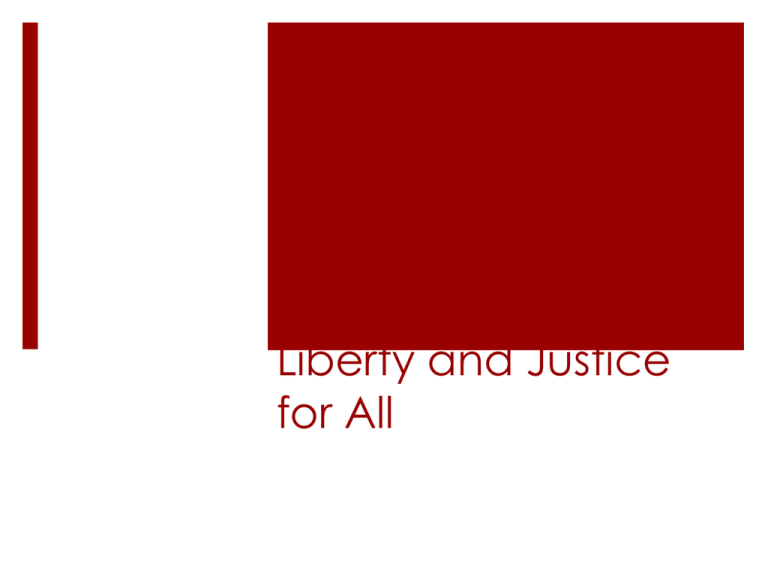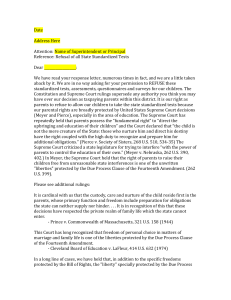Liberty and Justice for All
advertisement

Liberty and Justice for All What are Civil Rights? http://www.youtube.com/watch?v=gdTpU5WZH HM What does this speech mean to you? Issues in the News Page 355: How does this issue compare to Dr. King’s Speech? They both deal with Human Rights or Fundamental Freedoms which lie at the heart of the American Political System What are some of these rights? To speak freely? To read and write what they choose? To worship as they wish? Quick Review We know that the Constitution guarantees these rights. We also knows that it protects these rights. But who protects these rights? “Liberty lies in the heart of men and women; when it dies there, no constitution, no law, no court can save it; no constitution, no law, no court can even do much to help it.” What does this quote mean to you? We are Responsible As Citizens we share a common faith in the power we have to steer our government. If we do not carry out our responsibilities then the whole society suffers. The Bill of Rights As we know is our greatest protector of our Civil Rights and Liberties “Congress shall make no law” Did it apply to the states? Not at first? Barron Vs. Baltimore 1833 “The first ten amendments contain no expression indicating an intention to apply them to the state government.” John Marshall The 14th Amendment Paved the way for a major expansion of Individual rights It defined Citizenship: A person born or naturalized in the United States is a citizen of the nation and the state of residence However, it also made individual rights: national rights: Page 356 (Open your Books) Incorporation Definition: The process by which the Bill of Rights was extended to the states and localities Why is it important? The Answer If it was not incorporated states could possibly deny certain rights to certain citizens of that state. Example: The Poll Tax As a result of incorporation the Bill of Rights has become the final safeguard when personal rights are affected This does create controversy http://www.glencoe.com/video_library/index_wi th_mods.php?PROGRAM=9780078747625&VIDEO =2239&CHAPTER=13&MODE=2 Freedom Of Religion What does this issue in the news tell you? No matter how you feel you cannot deny that religion plays or has played a significant part of American Life Over 90% of Americans identify with a religion And Religious Freedom is guaranteed in the 1st Amendment So why can’t we pray here today? In order to understand that we have to understand the two clauses of the 1st Amendment The Establishment Clause “States that Congress shall make no law respecting an establishment of religion.” The Free Exercise Clause “Prohibits government from unduly interfering with the free exercise of religion.” The Establishment Clause http://www.firstamendmentcenter.org/rel_liberty /publiclife/overview.aspx Page 358 “Wall of Separation” Religion is Everywhere Government Officials take their oaths of office in the name of God. Since 1864 most of the nation’s coins carry the motto “In God we Trust” Pledge of Allegiance: “one nation under God” Public meetings including daily sessions of congress open with a prayer Does Government encourage religion? Chaplains serve with the army. Church property and contributions to religious groups are taxed exempt You can see how this leads to controversy And who is supposed to solve this controversy? The Supreme Court First Establishment Clause case did not come about until 1947 when it decided Everson vs. Board of Education State Aid to Parochial Schools, should the federal government give aid to these schools? 359-360: Read Carefully, What is the Lemon Test? 3 parts The Free Exercise Clause Religious Practice may be limited For example in Reynolds v. United States: George Reynolds, Polygamy case Oregon vs. Smith: Worker was denied unemployment benefits since he was fired for using drugs as part of a religious ceremony Wisconsin vs. Yoder: Court upheld religious practices by saying Amish parents did not have to send their children to school past 8th grade, since it violated Amish religious beliefs Religious Expression and the Flag Should you have to salute the flag? In 1936 William Gobitis was expelled from school for not saluting the flag- It was against his religious beliefs, so should he have to salute the flag Court said the school was correct- Saluting the flag did not infringe on religious freedom Page 364 Websites to Use: www.oyez.org http://www.firstamendmentcenter.org/rel_liberty/p ubliclife/overview.aspx http://www.law.cornell.edu/supct/ http://www.digitalhistory.uh.edu/supreme_court/su preme_court.cfm Freedom of Speech Open your books and carefully read on page 366 The Issue in The News and The First Paragraph before Types of Speech What do you think? Should the First Amendment protect the expression of unpopular ideas? Let’s define the word “Speech”: How many of you would agree with the following: Giving a Speech that to the student body at a student assembly . What about wearing black armbands to protest a war? Or protesting a law at the Capitol Are these all speech? Two Categories 1. Pure Speech: The Verbal Expression of thought and opinion before an audience that has chosen to listen This type of speech has traditionally been powerfully protected by the Supreme Court 2. Symbolic Speech: Sometimes called expressive conduct-involves the use of actions and symbols in addition to or instead of words to express opinions How does the Court Decide these symbolic test cases? They have developed a three part test; which they established in United States v. O’Brien 1. Falls within the Constitutional Power of Government 2. Narrowly Drawn: So government cannot use it further regulate speech 3. Leaves other Communication Outlets Are there other restraints? Yes, and there have to be: For example seditious speech: Which is speech urging resistance to lawful authority or advocating the overthrow of government But the challenge for the court is when to end these restraints Clear and Present Danger 1919 Page 368 When speech in question clearly presents an immediate danger, the First Amendment does not protect it The Bad Tendency Doctrine 1925 Speech could be restricted even if it had only a tendency to lead to illegal action. This is not often used But some Americans think that societies need for order justifies any damage to basic freedoms The Preferred Position Doctrine First Amendment comes first, above all others Any law limiting these freedoms should be found unconstitutional unless it is absolutely necessary. Sedition Laws: 369 Defamatory speech This kind of speech is not protected: This is speech that is either untrue or hurtful: Slander: Spoken Libel: Written However, public officials are held to a different standard Hustler Magazine vs. Farewell: sets up the standard that celebrities and politicians cannot sue for Defamatory speech Fighting Words Some words are so offensive that they are deemed as unprotected speech Chaplinsky v. New Hampshire (1942): Some words incite fighting, which is a breech of the peace and therefore are not protected. Right to Assemble “the right to peacefully assemble, and to petition the Government for a redress of grievances” Without this Freedom, no political parties and no special interest groups could exist to influence the actions of government Dejonge v. Oregon 1937 DeJonge Vs. Oregon Established two legal principles 1. Assembly is as important as the rights of free speech and free press 2. Due Process Clause Applies to Freedom of Assembly Are there limits on demonstrations? Yes, if there is any potential of violence- example KKK parade then perhaps the Court would rule in favor of a state not allowing the parade http://www.youtube.com/watch?v=fYh8MOnAg v8 To ensure public order and safety, many states require permits- so streets will not be blockedCox. V. New Hampshire Other Limits on Public Assembly Pg. 377 Adderly v. Florida= Cox v. Louisiana= Grayned v. City of Rockford= Freedom of Assembly does not apply to Private Property Assembly and Disorder This is when this Principle gets difficult The Big Three Stokie Case Feiner vs. New York Gregory vs. City of Chicago Are you allowed to Picket? Not until 1940 in Thornhill vs. Alabama did the Supreme Court Rule that peaceful Picketing was a form of Free Speech But since this case the court has begun to limit picketing Freedom of Association Can you join an organization that the government considers to be subversive? In DeJonge v. Oregon (1937) the Supreme Court extended the right to freely assemble Whitney Vs. California (1927) Dennis Vs. United States (1951)











